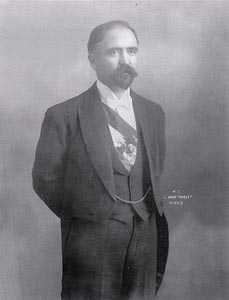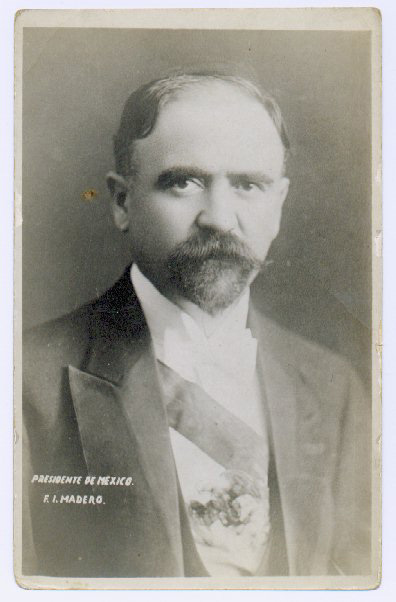Francisco Madero was a man who was too good for his own good. Naive, trusting, merciful toward those who deserved no mercy, he was in the end betrayed and murdered by those in whom he had mistakenly placed his trust. A rich man’s son whose following included bandits and killers, a teetotaler and spiritualist in a society dominated by hard-drinking machismo and mawkish veneration of saints’ images, he was such an odd-man-out that the terrible fate that overtook him seems almost inevitable.

Yet Madero was truly a figure who achieved vindication in martyrdom and death. Today, the plotters who laid him low are forgotten or reviled. By contrast, Madero’s memory is venerated everywhere, no town or city in Mexico is without a street that bears his name and the statues built in his honor would fill an armory.
His career was filled with contradictions. A white man, he led a movement of oppressed Indians against a government representing a European-descended establishment — but headed by an Indian. Born to wealth, he led a rebellion of the poor and downtrodden against a greedy power structure many of whose leaders had been born to poverty.
Madero’s family was one of the richest in Mexico. Originally of Portuguese-Jewish descent, Catholic for generations, the Maderos settled in the northern state of Coahuila where they made a fortune of diversified origin. Family interests included land, cotton, banks, mines, factories and a wine and spirit industry.
The future liberator was born at Parras de la Fuente, southern Coahuila, on October 30, 1873. Though he is usually known as Francisco Indalecio, legal documents and his marriage license list him as Francisco Ignacio. Like many privileged youths of his day, Madero received part of his education abroad — at a Catholic school in Baltimore, at a lycée in Paris and briefly at the University of California at Berkeley.

Young Madero was a supremely atypical product of his culture and environment. Where sons of wealthy ranching families tended to be hard-drinking, steak-devouring, woman-chasing “bloods” completely alienated from things of the intellect and spirit, Francisco didn’t drink, abstained from meat and believed in arcane mysticism. Though he was never known to lack courage, Madero’s five-foot-two-inch height and shrill, high-pitched voice did not exactly conform to the macho image that Mexicans associate with powerful leaders.
How did a man from such a privileged background become involved in revolutionary politics? Part of it had to do with a nature that literally overflowed with human kindness. While studying in Paris, Madero became known as the “Chocolate Fool” because of his custom of distributing sweets to the poor boys of his neighborhood.
Madero was also affected by instances of injustice that he witnessed in Mexico. One involved General Bernardo Reyes, governor of the neighboring state of Nuevo León, who was frequently talked of as a possible candidate for president. In 1903 Reyes bloodily suppressed a political manifestation in Monterrey. Another thing that disturbed Madero was the longevity in office and high-handed behavior of Porfirio Díaz. In 1904 Díaz had increased the length of the presidential term from four years to six and selected a highly unpopular politician named Ramón Corral as vice-presidential candidate. By choosing a man as widely disliked as Corral, Díaz operated on the cynical principle of “look what would follow if you got rid of me.”
In 1908 Madero published a book titled La sucesión presidencial en 1910 (“The Presidential Succession in 1910.”) Hardly inflammatory, this volume didn’t even call for Díaz to step down — it merely urged an honest election with the removal of Corral and representation for those who opposed Díaz’s reelection. But the book sparked a firestorm of anti-Díaz sentiment. A strong anti-reelection movement sprang up, complete with anti-reelection clubs and then an anti-reelection party, with Madero as its candidate.
Díaz began to grow alarmed. At first, he had considered Madero a joke, referring to him as el loquito (“the little madman”). At a meeting between the two, he caustically observed that “a man must be more than honest to govern Mexico.” But then he witnessed the groundswell of popular support for anti-reelectionism. On June 6, 1910, he had Madero arrested on charges of inciting to rebellion. Thrown into the penitentiary in San Luis Potosí, he was bailed out by his influential family. On October 4 the tame Chamber of Deputies made the expected announcement and officially declared Díaz and Corral winners in the rigged July election. Deciding that rebellion was inevitable, Madero jumped bail the next day and fled to the United States.
November 20 is celebrated in Mexico as the Day of the Revolution. If one wants to nitpick, it is the celebration of a fiasco. Madero crossed into Mexico with a few followers, the large force he was expecting didn’t materialize, and he was forced to recross the border.
But the Revolution was alive and well. Under such authentic popular leaders as the ex-rustler Pancho Villa, the ex-mule driver Pascual Orozco, and the ex-horse trainer Emiliano Zapata, a ragtag army was kicking down the rotting timbers of the Díaz regime. Madero rejoined the revolution and was on hand at the May 1911 battle at Ciudad Juárez that sealed Díaz’s fate. It was there that Madero’s trusting and forgiving nature first came into conflict with those who believed in playing hardball. Villa and Orozco had wanted to execute General Navarro, the federal commander at Juárez, because he had given the order to bayonet rebel prisoners. Madero, taking into account that Navarro was eighty years old, wished to release him. Following a stormy scene where Orozco threatened him with a pistol, Madero eventually had his way and Navarro was released. Though Pancho Villa, who enormously admired Madero, begged forgiveness for his part in the mutiny, Orozco forever held a grudge and would put his thoughts into action before too long.
After the defeat at Ciudad Juárez, Díaz resigned and went into exile. Madero made a triumphal entry into the capital in June 1911. In October he was elected president by a huge margin in what was probably the most honest election in Mexican history.
But euphoria would soon vanish. In March 1912 a resentful Pascual Orozco, armed and financed by the Chihuahua cattle barons, mounted a counterrevolution. To smash Orozco, Madero called on one of the most sinister figures in Mexican history, General Victoriano Huerta. Huerta resembled Grant in that he was an able general and a heavy drinker. There the resemblance ceased. A treacherous intriguer who would become a despot, Huerta was called on by a hesitant Madero, who disapproved of his drinking. In a brilliant campaign, Huerta inflicted five successive defeats on the orozquistas, whose leader crossed the U.S. border in September. Though Madero congratulated Huerta on his stellar military performance, he also asked him to give an accounting of funds expended in the campaign. Huffily responding that he was not a bookkeeper, Huerta went on the inactive list and from then on was totally dedicated to Madero’s downfall.
Another conspirator against the trusting Madero was an individual who surely rates as the worst ambassador in the annals of U.S. diplomatic history. Henry Lane Wilson, hatchet man for big business and apostle of dollar diplomacy, longed for the good old days of Porfirio Díaz. Then there had been a favorable climate for the global capitalism of its day and the masses were held firmly in check. Admiration for Díaz was a common bond between Wilson and Huerta, the latter having wept when the old dictator was deposed and commanded the guard train that took him into exile. Another bond between them was a fondness for the bottle. Their attitude toward Madero was similar to that of two barroom bullies who taunt and ridicule a teetotaling Sunday school teacher. “You cannot imagine the impertinences of (Wilson),” said Madero to an associate. “In a few months Woodrow Wilson will become president of the United States and he is my friend … I will ask him to change ambassadors. This Henry Lane Wilson is an alcoholic … Madero, infuriated by Henry Lane Wilson’s arrogant and patronizing attitude, was delighted by the unrelated Woodrow Wilson’s victory in the 1912 presidential race and looked forward to his becoming president in March 1913.
It was a March he would never see. On February 9 a violent artillery duel broke out in Mexico City. This was in conjunction with a sham battle staged to create an atmosphere of confusion that would facilitate the removal of Madero. The “rebels,” secretly in league with Huerta, were led by Félix Diaz, the old dictator’s nephew. Again, Madero’s trusting nature would lead to disaster. General Villar, who commanded loyalist forces in the plaza, was wounded and Madero appointed Huerta to take his place. Though he neither liked nor trusted Huerta, Madero overrode most of his advisers in making the appointment. Possibly he had in mind Huerta’s skilled leadership during Pascual Orozco’s rising.
Though this was a fake battle at the higher levels, there was nothing imaginary about the terrible toll of civilian casualties. Taking advantage of widespread desire for the terror to end, Huerta had Madero arrested on February 18.Then he sent the following wire to President Taft: I HAVE THE HONOR TO INFORM YOU THAT I HAVE OVERTHROWN THIS GOVERNMENT … FROM NOW ON PEACE AND PROSPERITY WILL REIGN.”
In there ever was an unindicted co-conspirator in a great international crime, it was Henry Lane Wilson. He had previous knowledge of the plot, his admiration for Huerta and contempt for Madero were well-known and — the worst blot on his record — he disregarded all pleas to save Madero’s life. The day after Madero’s arrest Huerta asked Wilson what he should do with Madero — banish him or put him in an insane asylum. In a Pontius Pilate gesture, Wilson replied that Huerta “ought to do what is best for the country.”
The murderous Huerta saw this as carte blanche to deal with the Madero situation as he saw fit. On February 22nd, while being transferred to another prison by car, Madero was shot dead by one of his captors. Huerta immediately declared that the deposed president had been killed in the crossfire when a group of sympathizers tried to rescue him. To lend credence to Huerta’s fabrication, the faithful Henry Lane Wilson issued a statement insisting that it was the truth. Equally sordid was the announcement of a pact between Huerta and his “enemy,” Félix Díaz, that Díaz would succeed him as president. (That Huerta later doublecrossed Díaz is beside the point.) There is a final grotesque touch. February 22, the day of Madero’s murder, is Washington’s birthday. That night Wilson invited Huerta to a reception at the American embassy. There the two conspirators poured champagne and lifted their glasses in a toast — to George Washington.
History has a way of setting events into proper perspective. In January 1954 a Gallup poll showed Harry Truman to be a highly unpopular ex-president and revealed that 50 percent of the American people approved of Senator Joe McCarthy’s investigations. (As opposed to 29 percent who disapproved.) Today Truman is widely respected and McCarthy’s name has become a synonym for political gangsterism. Right after Madero’s deposition and murder, many Americans believed Henry Lane Wilson’s claim that Madero was “a man of disordered intellect” and Huerta “the Mexican Cromwell.” Today, Madero shares honors with Juárez and Hidalgo in the pantheon of Mexican heroes while Huerta is universally despised and Wilson is a figure of opprobrium on both sides of the border.
